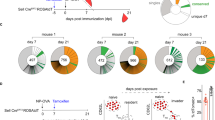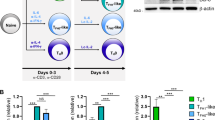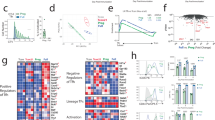Abstract
Follicular helper (TFH) cells provide crucial signals to germinal center B cells undergoing somatic hypermutation and selection that results in affinity maturation. Tight control of TFH numbers maintains self tolerance. We describe a population of Foxp3+Blimp-1+CD4+ T cells constituting 10–25% of the CXCR5highPD-1highCD4+ T cells found in the germinal center after immunization with protein antigens. These follicular regulatory T (TFR) cells share phenotypic characteristics with TFH and conventional Foxp3+ regulatory T (Treg) cells yet are distinct from both. Similar to TFH cells, TFR cell development depends on Bcl-6, SLAM-associated protein (SAP), CD28 and B cells; however, TFR cells originate from thymic-derived Foxp3+ precursors, not naive or TFH cells. TFR cells are suppressive in vitro and limit TFH cell and germinal center B cell numbers in vivo. In the absence of TFR cells, an outgrowth of non–antigen-specific B cells in germinal centers leads to fewer antigen-specific cells. Thus, the TFH differentiation pathway is co-opted by Treg cells to control the germinal center response.
This is a preview of subscription content, access via your institution
Access options
Subscribe to this journal
Receive 12 print issues and online access
$209.00 per year
only $17.42 per issue
Buy this article
- Purchase on Springer Link
- Instant access to full article PDF
Prices may be subject to local taxes which are calculated during checkout






Similar content being viewed by others
References
Smith, K.G.C., Light, A., Nossal, G.J.V. & Tarlinton, D.M. The extent of affinity maturation differs between the memory and antibody-forming cell compartments in the primary immune response. EMBO J. 16, 2996–3006 (1997).
Guo, W. et al. Somatic hypermutation as a generator of antinuclear antibodies in a murine model of systemic autoimmunity. J. Exp. Med. 207, 2225–2237 (2010).
Vinuesa, C.G., Sanz, I. & Cook, M.C. Dysregulation of germinal centres in autoimmune disease. Nat. Rev. Immunol. 9, 845–857 (2009).
Victora, G.D. et al. Germinal center dynamics revealed by multiphoton microscopy with a photoactivatable fluorescent reporter. Cell 143, 592–605 (2010).
Linterman, M.A. et al. Follicular helper T cells are required for systemic autoimmunity. J. Exp. Med. 206, 561–576 (2009).
Vinuesa, C.G. et al. A RING-type ubiquitin ligase family member required to repress follicular helper T cells and autoimmunity. Nature 435, 452–458 (2005).
Kim, H.J., Verbinnen, B., Tang, X., Lu, L. & Cantor, H. Inhibition of follicular T-helper cells by CD8(+) regulatory T cells is essential for self tolerance. Nature 467, 328–332 (2010).
Lim, H.W., Hillsamer, P., Banham, A.H. & Kim, C.H. Cutting edge: direct suppression of B cells by CD4+ CD25+ regulatory T cells. J. Immunol. 175, 4180–4183 (2005).
Lim, H.W., Hillsamer, P. & Kim, C.H. Regulatory T cells can migrate to follicles upon T cell activation and suppress germinal center-Th cells and germinal center-Th cell-driven B cell responses. J. Clin. Invest. 114, 1640–1649 (2004).
Fields, M.L. et al. CD4+ CD25+ regulatory T cells inhibit the maturation but not the initiation of an autoantibody response. J. Immunol. 175, 4255–4264 (2005).
Fontenot, J.D., Gavin, M.A. & Rudensky, A.Y. Foxp3 programs the development and function of CD4+ CD25+ regulatory T cells. Nat. Immunol. 4, 330–336 (2003).
Hori, S., Nomura, T. & Sakaguchi, S. Control of regulatory T cell development by the transcription factor Foxp3. Science 299, 1057–1061 (2003).
Khattri, R., Cox, T., Yasayko, S.A. & Ramsdell, F. An essential role for Scurfin in CD4+ CD25+ T regulatory cells. Nat. Immunol. 4, 337–342 (2003).
Bennett, C.L. et al. The immune dysregulation, polyendocrinopathy, enteropathy, X-linked syndrome (IPEX) is caused by mutations of FOXP3. Nat. Genet. 27, 20–21 (2001).
Wildin, R.S. et al. X-linked neonatal diabetes mellitus, enteropathy and endocrinopathy syndrome is the human equivalent of mouse scurfy. Nat. Genet. 27, 18–20 (2001).
Koch, M.A. et al. The transcription factor T-bet controls regulatory T cell homeostasis and function during type 1 inflammation. Nat. Immunol. 10, 595–602 (2009).
Zheng, Y. et al. Regulatory T-cell suppressor program co-opts transcription factor IRF4 to control T(H)2 responses. Nature 458, 351–356 (2009).
Chaudhry, A. et al. CD4+ regulatory T cells control TH17 responses in a Stat3-dependent manner. Science 326, 986–991 (2009).
Fontenot, J.D. et al. Regulatory T cell lineage specification by the forkhead transcription factor foxp3. Immunity 22, 329–341 (2005).
Chtanova, T. et al. T follicular helper cells express a distinctive transcriptional profile, reflecting their role as non-Th1/Th2 effector cells that provide help for B cells. J. Immunol. 173, 68–78 (2004).
Huehn, J. et al. Developmental stage, phenotype, and migration distinguish naive- and effector/memory-like CD4+ regulatory T cells. J. Exp. Med. 199, 303–313 (2004).
Yoshida, K. et al. Bcl6 controls granzyme B expression in effector CD8+ T cells. Eur. J. Immunol. 36, 3146–3156 (2006).
Cretney, E. et al. The transcription factors Blimp-1 and IRF4 jointly control the differentiation and function of effector regulatory T cells. Nat. Immunol. 12, 304–311 (2011).
Linterman, M.A. et al. Roquin differentiates the specialized functions of duplicated T cell costimulatory receptor genes CD28 and ICOS. Immunity 30, 228–241 (2009).
Linterman, M.A. & Vinuesa, C.G. Signals that influence T follicular helper cell differentiation and function. Semin. Immunopathol. 32, 183–196 (2010).
Salomon, B. et al. B7/CD28 costimulation is essential for the homeostasis of the CD4+ CD25+ immunoregulatory T cells that control autoimmune diabetes. Immunity 12, 431–440 (2000).
Tang, Q. et al. Cutting edge: CD28 controls peripheral homeostasis of CD4+ CD25+ regulatory T cells. J. Immunol. 171, 3348–3352 (2003).
Cannons, J.L. et al. Optimal germinal center responses require a multistage T cell:B cell adhesion process involving integrins, SLAM-associated protein, and CD84. Immunity 32, 253–265 (2010).
Qi, H., Cannons, J.L., Klauschen, F., Schwartzberg, P.L. & Germain, R.N. SAP-controlled T-B cell interactions underlie germinal centre formation. Nature 455, 764–769 (2008).
Deenick, E.K. et al. Follicular helper T cell differentiation requires continuous antigen presentation that is independent of unique B cell signaling. Immunity 33, 241–253 (2010).
Johnston, R.J. et al. Bcl6 and Blimp-1 are reciprocal and antagonistic regulators of T follicular helper cell differentiation. Science 325, 1006–1010 (2009).
Nurieva, R.I. et al. Bcl6 mediates the development of T follicular helper cells. Science 325, 1001–1005 (2009).
Yu, D. et al. The transcriptional repressor Bcl-6 directs T follicular helper cell lineage commitment. Immunity 31, 457–468 (2009).
Shaffer, A.L. et al. Blimp-1 orchestrates plasma cell differentiation by extinguishing the mature B cell gene expression program. Immunity 17, 51–62 (2002).
Shaffer, A.L. et al. BCL-6 represses genes that function in lymphocyte differentiation, inflammation, and cell cycle control. Immunity 13, 199–212 (2000).
Zhou, L., Chong, M.M. & Littman, D.R. Plasticity of CD4+ T cell lineage differentiation. Immunity 30, 646–655 (2009).
Thornton, A.M. et al. Expression of Helios, an Ikaros transcription factor family member, differentiates thymic-derived from peripherally induced Foxp3+ T regulatory cells. J. Immunol. 184, 3433–3441 (2010).
Kim, J.M., Rasmussen, J.P. & Rudensky, A.Y. Regulatory T cells prevent catastrophic autoimmunity throughout the lifespan of mice. Nat. Immunol. 8, 191–197 (2007).
Tsuji, M. et al. Preferential generation of follicular B helper T cells from Foxp3+ T cells in gut Peyer's patches. Science 323, 1488–1492 (2009).
Rubtsov, Y.P. et al. Regulatory T cell–derived interleukin-10 limits inflammation at environmental interfaces. Immunity 28, 546–558 (2008).
Rubtsov, Y.P. et al. Stability of the regulatory T cell lineage in vivo. Science 329, 1667–1671 (2010).
Chan, T.D. et al. Antigen affinity controls rapid T-dependent antibody production by driving the expansion rather than the differentiation or extrafollicular migration of early plasmablasts. J. Immunol. 183, 3139–3149 (2009).
Willinger, T., Freeman, T., Hasegawa, H., McMichael, A.J. & Callan, M.F. Molecular signatures distinguish human central memory from effector memory CD8 T cell subsets. J. Immunol. 175, 5895–5903 (2005).
Martins, G.A. et al. Transcriptional repressor Blimp-1 regulates T cell homeostasis and function. Nat. Immunol. 7, 457–465 (2006).
Schmidt, E.M. et al. Ctla-4 controls regulatory T cell peripheral homeostasis and is required for suppression of pancreatic islet autoimmunity. J. Immunol. 182, 274–282 (2009).
Wing, K. et al. CTLA-4 control over Foxp3+ regulatory T cell function. Science 322, 271–275 (2008).
Vinuesa, C.G., Tangye, S.G., Moser, B. & Mackay, C.R. Follicular B helper T cells in antibody responses and autoimmunity. Natl. Rev. Immunol. 5, 853–865 (2005).
Hsu, H.C. et al. Interleukin 17–producing T helper cells and interleukin 17 orchestrate autoreactive germinal center development in autoimmune BXD2 mice. Nat. Immunol. 9, 166–175 (2008).
Gräbner, R. et al. Lymphotoxin beta receptor signaling promotes tertiary lymphoid organogenesis in the aorta adventitia of aged ApoE−/− mice. J. Exp. Med. 206, 233–248 (2009).
Wehner, J.R. et al. B cells and plasma cells in coronaries of chronically rejected cardiac transplants. Transplantation 89, 1141–1148 (2010).
Acknowledgements
We thank X. Hu and J. Fitch for technical assistance, D. Zotos for help with experiments not included in this manuscript, A. Rudensky for kind provision of Foxp3gfp mice and M. Espeli for helpful discussions. This work was funded by National Health and Medical Research Council program and project grants to C.G.V., a Vlaams Instituut voor Biotechnologie principal investigator grant to A.L. and a Wellcome Trust Programme grant (083650/Z/07/Z) to K.G.C.S. M.A.L. is supported by an EMBO post-doctoral long-term fellowship (ALTF 1041-2009) and a Raymond and Beverly Sackler Junior Research Fellowship, Churchill College, Cambridge; C.G.V. is supported by a Viertel Senior Medical Research Fellowship; K.G.C.S. is supported by a Lister Prize Fellowship; T.F.R. is supported by the National Institute of Health Research, Cambridge Biomedical Research Centre; and A.L. is supported by a Juvenile Diabetes Research Foundation Career Development Fellowship and a Marie Curie Reintegration Grant Fellowship.
Author information
Authors and Affiliations
Contributions
M.A.L. designed and performed experiments, analyzed the data and wrote the manuscript. W.P. performed experiments. S.K.L. performed experiments. A.K. contributed Blimp-1 chimera experiments and reviewed the manuscript. S.K. contributed confocal microscopy images. T.F.R. performed bioinformatic analyses. M.S. performed qRT-PCR experiments. D.P.D., L.B. and J.J.H. performed experiments. S.F. contributed confocal microscopy images and reviewed the manuscript. A.L. designed experiments and reviewed the manuscript. K.G.C.S. designed experiments, wrote the manuscript and supervised the study. C.G.V. designed experiments, wrote the manuscript and supervised the study.
Corresponding authors
Ethics declarations
Competing interests
The authors declare no competing financial interests.
Supplementary information
Supplementary Text and Figures
Supplementary Figures 1–11, Supplementary Table 2 and Supplementary Methods. (PDF 1239 kb)
Supplementary Table 1
Differentially expressed genes in TFR cells (XLS 361 kb)
Rights and permissions
About this article
Cite this article
Linterman, M., Pierson, W., Lee, S. et al. Foxp3+ follicular regulatory T cells control the germinal center response. Nat Med 17, 975–982 (2011). https://doi.org/10.1038/nm.2425
Received:
Accepted:
Published:
Issue Date:
DOI: https://doi.org/10.1038/nm.2425
This article is cited by
-
T follicular regulatory cells keep B cell-directed autoreactivity in check
Cell Research (2024)
-
Triptolide regulates the balance of Tfr/Tfh in lupus mice
Advances in Rheumatology (2023)
-
Tumor-specific cholinergic CD4+ T lymphocytes guide immunosurveillance of hepatocellular carcinoma
Nature Cancer (2023)
-
Conserved stromal–immune cell circuits secure B cell homeostasis and function
Nature Immunology (2023)
-
The aging of the immune system and its implications for transplantation
GeroScience (2023)



